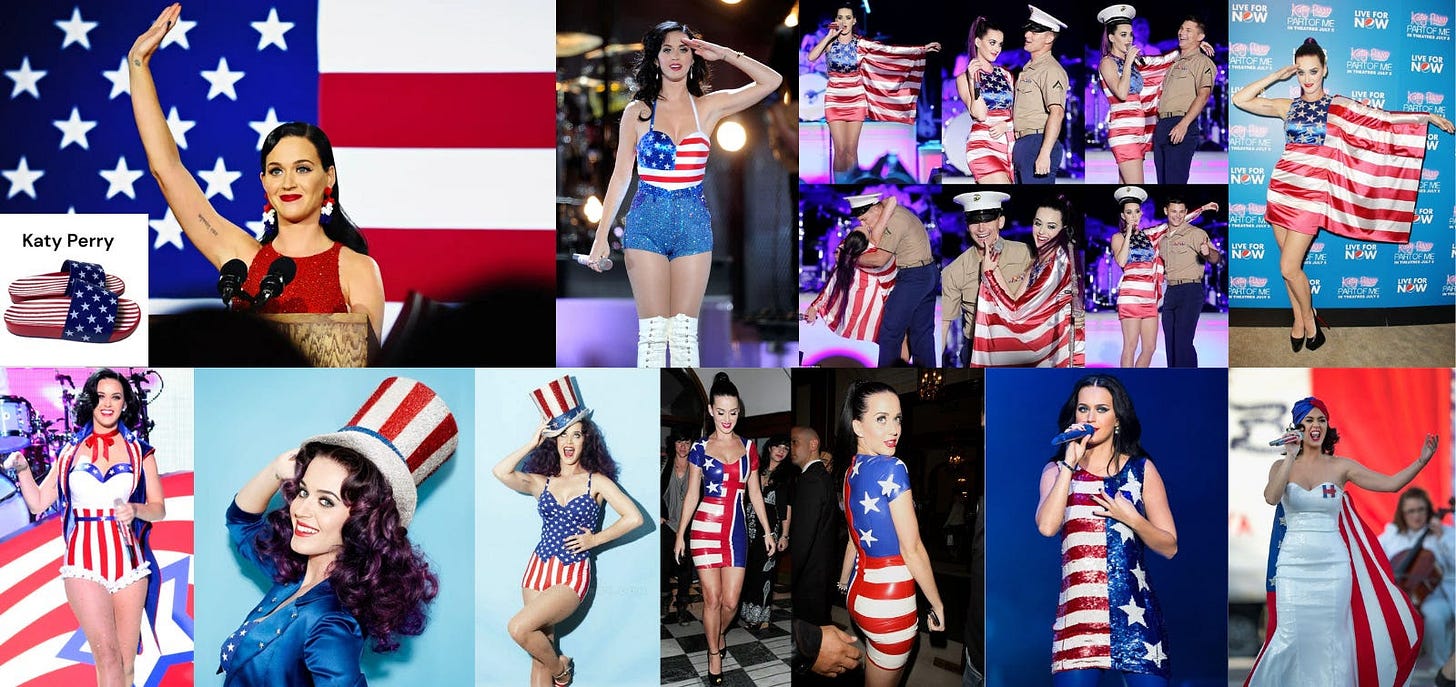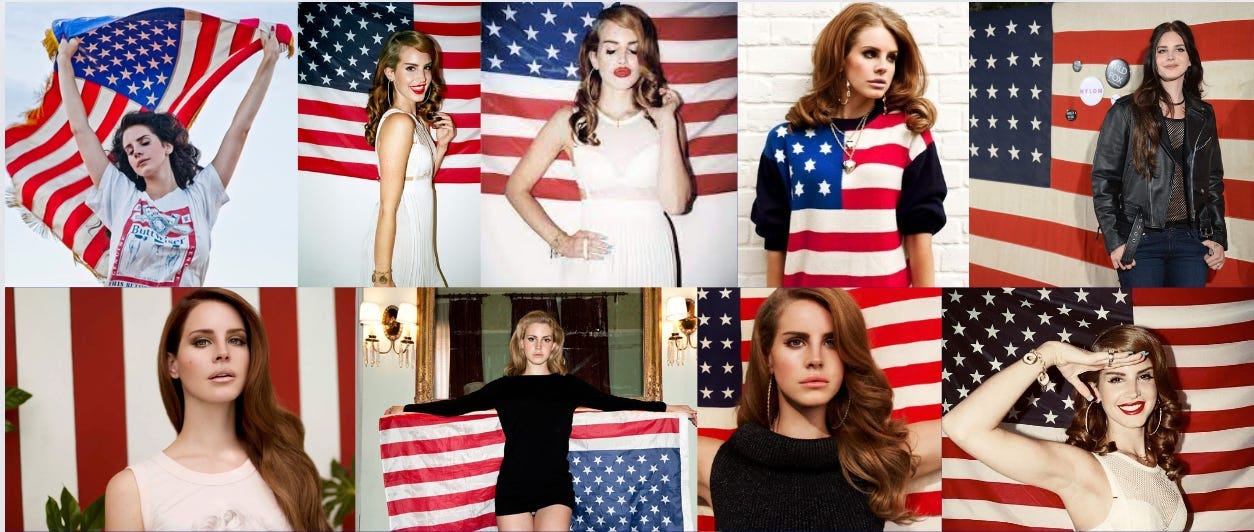The American flag's pop culture irony
The patriotism, transgression, performance, and fragmentation of the evolving motif
Find Nicstalgia on Substack? Welcome to your new favorite destination for deep conversations about superficial things! If you’re not already subscribed, please do so. Subscribers, thank you!! 💖 Feel free to share this with your friend who wants a hot dog real bad this weekend.
An American flag is worth a thousand words. The immediately recognizable, emotionally-charged motif is imbued with layers of irony, as its symbolic meaning reflects America’s continuously evolving sociopolitical climate. There are always exceptions – and I am focusing on broader, historically liberal-leaning pop culture rather than the specific, conservative-leaning country music genre – but generally, the cycle of the recent past is broken down into four waves.
Sincerity
While brands had long used the American flag as a primary motif, the prosperity of the 1990s gave rise to a distinctly market-friendly patriotism. Americana labels celebrating blue-collar values (Carhartt), Western cowboy heritage (Wrangler), and open-road freedom (Harley-Davidson), as well as preppy brands geared toward an upper-class white consumer (Ralph Lauren), all embraced the flag as a symbol of traditional American aspiration. Tommy Hilfiger built an aspirational lifestyle empire on patriotic iconography, and no one else capitalized off Black kids’ desire to be ‘rich’ and white kids’ desire to be ‘cool’ better.1 New pop star Britney Spears also embodied a sincere American ideal. Her Christian, Southern upbringing fit perfectly with the era’s family-values narrative, making the “good girl” archetype a highly bankable symbol of American patriarchy and purity culture.
This was a period of rabid consumerism and rising materialism, paired with anxieties over the rapid shift to foreign production in search of cheaper labor. The flag offered a comforting sense of national pride and belonging during this time of change toward globalization and corporate expansion. “Made in the USA” labels boosted consumer confidence, though, in practice, Americans ultimately prioritized unbridled consumption over ethical production. Patriotic mass production is epitomized by Old Navy, who has now created annual Fourth of July t-shirts – for the whole family! – for over a quarter of a century.
After September 2001, the American flag flew proudly, even at half-mast. It remained an emotionally resonant symbol of strength and unity, signaling to the world that the United States was still the only global superpower. Despite being a country with deep-seated systemic inequalities, Americans were united against a common foreign enemy. Sales of flags and flag-themed merchandise post 9/11 surged, commodifying national pride and hopeful optimism for a united future. Fear over national security was tempered by the urge to do what Americans do best – spend money.2
Patriotism became chic! The November 2001 issue of Vogue, the first released since 9/11, almost predictably had Britney Spears on the cover. The article “True Colors” signaled patriotism as a trend, with Catherine Malandrino and Viktor & Rolf already incorporating the flag design into their collections. The article “Up In Arms”, about a writer getting trained by a professional dancer to have skinnier arms, is supplemented with a photo of a SS02 Donna Karan dress with a small American flag placed on the hip.3 “Amazing Grace” recalls how 9/11 affected New York Fashion Week and how the industry is moving forward “[deciding] what to wear when you have weightier things on your mind than fashion.” But by the time this issue was released, the war in Afghanistan had already begun. By the time US forces invaded Iraq in 2003, the era of sincerity was over.
Irony
Because the flag is a generally revered symbol, any subversion of its meaning is viewed as blasphemous – until it isn’t. Madonna’s 2001 Drowned World Tour, having been recorded less than two weeks prior to 9/11, featured the singer performing her 1994 song “Human Nature” wearing an American flag shirt and riding a mechanical bull amidst a sea of sweaty, sexy, shirtless men. By the mid-2000s, the American-flag-as-ironic era served as a reflection of the nihilistic, exploitative, supersized, celebrity-obsessed, gossip-driven tabloid culture. Jessica Simpson and Courtney Love adorning American flag-marked bikinis and corsets on magazine covers depicted transgression and tension between secular and fundamentalist ideals of the time. The plummeting presidential approval rate and pop cultural milestones like Green Day’s American Idiot (2004) represented a flippant cynicism toward America and its leadership. Saluting the American flag meant complying with the government, and Gen X would never sell out the way that Boomers did.
Paris Hilton is the most-photographed celebrity in any context, and her appearing with an American flag – to this day – is no exception. Despite being derided as a superficial socialite (before we knew about the creation of her baby-voiced airhead character as a trauma response), Paris was still massively influential. She’s emblematic of the undeterred, steadfast devotion to American neoliberalism. Paris’s provocative, scantily-clad photos in front of the stars & stripes serve as a cheeky reminder that despite her financially privileged status as an heiress, meritocracy must be real. Her sex appeal made her initial associations ironic, but since her recent redemption arc, her patriotism shifts into post-ironic territory. Blondes have more fun because of free-market capitalism, the drive to maximize productivity and profit, and the ability to girlboss their way to the top. America exploited Paris, but she laughs all the way to the bank.
By the end of the decade, the focal generation of youth culture shifted from Gen X to Millennials.4 We had a new president and also a massive economic recession. Miley Cyrus’s “Party in the U.S.A.” (2009) might seem like a cheesy, sincere pop song, but it’s actually the perfect example of the 21st century American Dream. Ironically. Shit is still falling apart, so we might as well have a good time! This disenchantment with realities of American adulthood, coupled with the interconnectedness granted by the mass adoption of social media, ushered in a new era.
Post-Irony
The post-ironic representation of the American flag in the early-to-mid 2010s is rooted in performance and an aestheticized naiveté. Interestingly, this is the first era where images of the flag are distributed and consumed digitally rather than through a tangible way, like a magazine or an actual physical flag. The flag becomes a sort of simulacrum, where the flag’s aesthetic has a greater cultural impact than a genuine representation of its true meaning. Online, social media platforms like Pinterest, Tumblr, and Instagram drove an Americana aesthetic. Offline, Americana was often intertwined with hipster culture (mustaches, breweries, beards, bicycles), festival culture (Coachella, etc.), and prep culture (frat boys and sorority girls). The prevalence of blogs introduced a palatable, mass-accessible feminine style, where norms and conventions were peer-defined (as opposed to top-down advice from magazines of yesteryear). This universally-acceptable style is what is considered ‘basic’ or even ‘cheugy’ in present-day. Navigating the nuance of identity politics and personal style is what led to the meta-ironic era that would come next.
In the original iteration of this essay, I positioned Katy Perry as meta-ironic, basically to demonstrate that no one can ever interpret what the hell she is doing. While that became even more true since last year, her existence across the broad spectrum from kitsch to cringe has shifted into post-ironic territory. Katy Perry has adorned this motif so frequently it makes my head spin, from her Uncle Sam cosplay to the stars-and-stripes-adorned branded Katy Perry flip flops.5 Both sides of the aisle could agree on one thing: her political loyalty and activism seemed contrived. When Katy got political, her career immediately flopped. To be fair, this was also in part because her music was awful. But pushing a political agenda to regain cultural relevance and prioritize financial gain is as American as it gets in the 2010s. (Perry’s marriage to now-conservative evangelist Russell Brand is Horseshoe Theory in full effect.)
This blind cultural faith in performative, aestheticized politics – later called “woke” politics, rebelled against in the 2020s – is what left so many Clinton supporters blindsided by the results of the 2016 election. Unfortunately, the Broad City cameo didn’t move the needle as genuine political change. The digital-era flag-waving turned out to be as hollow and ineffective as Perry’s own superficial displays of Americana.
There is a kind of self-awareness to this brand of patriotism, with exhaustion toward late-stage capitalism accompanied by a coy little wink. “Money is the reason we exist. Everybody knows it, it’s a fact, kiss, kiss!!” Because this is my generation, I have such a soft spot for Lana Del Rey’s Born To Die era. Its retro, kitschy, nostalgic Americana aesthetic harkens back to JFK and the 1960s with declinism bias, romanticizing the past and looking back as though everything was better back in the good old days, whenever that was. “Be young, be dope, be proud” sounds so ridiculous now, but in the 2010s, it was a post-ironic quote made in Pinterest heaven. LDR famously abandoned the flag motif for her tour visuals post-2016, as she recognized a major shift in culture and the new meaning and politics behind the American flag motif.
Meta-Irony
In the meta-ironic era of the late 2010s and early 2020s, the meaning of the American flag is skewed, misunderstood, and disagreed upon. Online misinformation is rampant, and our society determines value based on who can get the greatest amount of money and eyeballs the fastest. Social media algorithms reinforce confirmation bias and only show people what they want to see. There is fragmentation down racial, class, and political lines in regards to what the American flag actually means, although most employ the flag as a means of strategic protest. Black artists have explored the flag’s complex symbolism, including Joey Bada$$ in the “Land of the Free” music video (2017) and Kendrick Lamar’s 2025 Super Bowl performance (2025). In this context, the flag is used to address and establish accountability to eradicate systemic inequalities like racism. Country artists often use the American flag to mark their territory, figuratively and literally, using the flag as a resistance toward progressive social values or a return to American traditionalism. Beyoncé’s Cowboy Carter album cover, considered controversial to some, is the middle of the Venn Diagram here, reclaiming space in a historically white-dominated genre and defining what intersectional patriotism means.
The meta-ironic era also saw the mainstream rise of stan culture and toxic fandom. American flags often mock militancy, equating “serving” and “service” with undying devotion to a celebrity. A viral video of a fan waving a Nicki Minaj flag has been heavily circulated. Online, it seems like everything is a joke, even a once-revered symbol of national pride like the American flag.
American flag sweatshirts from Brandy Melville went viral, as girls commented they were wearing the flag in a Lana Del Rey way, not a conservative-coded way. Obviously this was a trending joke, but it’s meta-ironic in that some people genuinely can’t make the distinction. Social media is fueled by context collapse, which has desecrated media literacy. Critical thinking skills required to pick up on nuance are thrown to the wayside in favor of rage bait. Vogue’s “Can You Wear the American Flag Without Irony?” (2024) explained the landscape of more recent years, where identity politics are fully baked into how American flags signify partisanship in a way they didn’t ten years ago. From the Chappell Roan camouflage Midwest Princess merch used by the Harris presidential campaign, to the Trailer Park Princess aesthetic, to Lana Del Rey working at Waffle House and marrying a Louisianan alligator tour boat driver, both sides of the political aisle were playing a tug-of-war over camo print hats, white tank tops, and cowboy boots. But what are we really fighting for? Whomever can reclaim the American flag as a symbol of unity – for the people instead of against them – will win.
Huge thank you to the people who go above and beyond to support my work: Janine, Marie, Liv, CY, Chet, Jack, Matthew P., Matthew M., and Emily! À la Jessica Simpson, I’m gonna love you forever 💐💐💐 If you enjoy Nicstalgia, please consider supporting the most fun newsletter about offbeat, obscure, and niche pop culture.
Newsletter ☆ Instagram ⟡ Website ♡ Podcast Archive ☆ Fitness Schedule ⟡ Physical Media Renaissance™ Zine
Once you know that Tommy Hilfiger knew Andy Warhol, the trickle-up effect – taking aspects of ‘low’ culture, commodifying it, and selling it back to consumers as a fresh take on ‘high’ culture – all starts to make sense.
I talked to Y2K author Colette Shade about how I inadvertently went on a GWB-approved trip to Disney World in September 2001 – the ultimate display of American patriotism.
Had no idea until reading the “Politically Correct” article from this issue that fashion designer Kenneth Cole has been married to Maria Cuomo since 1987.X
If you really wanna get granular about this, this is my personal scientific opinion: I think the generational handoff is right before (1-2 years) the youngest members of a generation reach The Chasm™, officially ending their tenure as a member of the focal generation of youth culture. For example, the handoff from Millennial to Gen Z was 2021, when the youngest (1996) was 25 years old. Handoff from Gen X to Millennial was in 2005, when the youngest (1980) was 25. Handoff from Boomer to Gen X would be in 1989, when the youngest (1964) was 25. I will write my full The Chasm™ essay one day, I swear :)
I do love Katy’s kitsch-tastic One of the Boys era, which features the song “Thinking of You”. In the music video, she’s a religious military wife of a soldier who was killed in France during World War II. Fun fact, he’s played by Matt Dallas of Kyle XY notoriety.




















